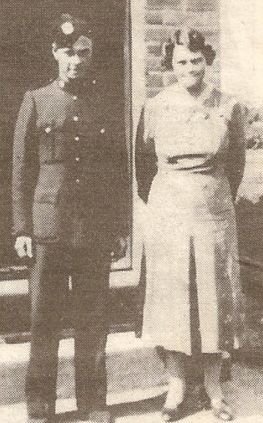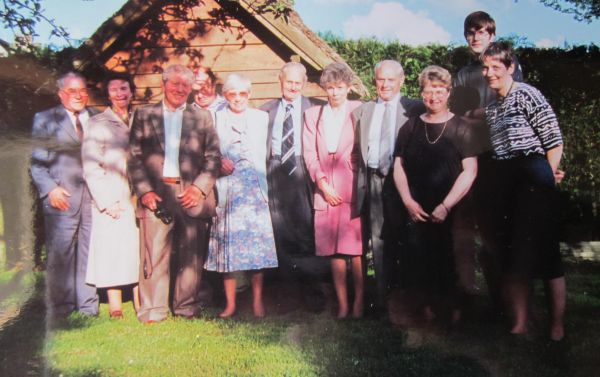 |
VAUDRY 1944-2014 . |
 |
VAUDRY 1944-2014 . |
 Athur Papworth and his mother Louise Papworth of 20 Council Houses, Ramsey Mereside Peterborough Evening Telegraph, 1994 Arthur Papworth est un des 51 soldats britanniques tués le 8 août 1944 lors des combats pour la libération de Vaudry. Il a été enterré dans le cimetière communal, pas dans le cimetière militaire de Saint-Charles-de-Percy. Après guerre, le couple Fouquet a noué des contacts avec la famille. En 1994, en présence de membres de la famille, le conseil municipal a donné son nom à l’école communale. Chaque 8 mai une cérémonie patriotique a lieu et sa tombe est fleurie. Des membres de la famille viennent régulièrement honorer sa mémoire. The medals of Arthur Papworth has been given to the town of Vaudry en 1994 http://ramsey-and-district.ccan.co.uk/medals/ |
Arthur Papworth (1921-1944)
The Royal Norfolk Regiment
Arthur Papworth will never forgotten in Vaudry, even though few might remember him in his birthplace of Ramsey Mereside.He was one of 51 British soldiers who died there on August 8, 1944 fighting to free the little village in northern France two months after the Allied invasion.He was only 23. He hadn’t had time to do much with his short life except give it for freedom, and the French have never forgotten his sacrifice. Neither will future generations, because Vaudry,s new school will be named the Arthur Papworth.The ceremony will be held at the end of May, and a strong contingent of the Papworth family will be there to pay their own homage.It will include his sister, Mavis Marriott, who lives with her husband Donald in Glebe Road Peterborough, Mavis will speak on behalf of the family.‘’Arthur’s picture is in the Vaudry town hall, and there is another in the church. His medals we gave them are paraded on the cusion at the annual liberation service,’’ said Mavis.Why Arthur was selected out of the 51 British soldiers who were killed (14 of them from the Lincolnshire Regiment) is an intriguing story. Exactly how he died is not clear, but Donald hopes to sort that out when they are over there. As far as he and Mavis know, Arthur was bayoneted in hand-to-hand fighting at a spot villagers still identify.‘’He didn’t die straight away.’’ Said Mavis. ‘’A man named Maurice, still alive, looked after him by the roadside. He knew he was going to die, and he asked to be buried in the village cemetery.’’They are not sure if Arthur lived for hours or days, but it was long enough to form a bond with the villagers. They remembered his request and buried him in the cemetery.The others, and 40 Germans who also died in what was obviously a grim fight, were laid to rest in a military cemetery. ‘’They seem to treat Arthur’s grave as a memorial to all the fallen,’’ said Mavis.Arthur’s brother, George, of Chatteris (he will be at the school naming ceremony) went over there a few years ago with some Fenland soil to put on the grave.The villagers said there was no need – Arthur was already in Little England, 300 miles from Ramsey Mereside. Arthur was born at 29 Council Houses. It was one of a pair demolished a few years ago. His mother was Louise and his father was Walter, whose service in World War 1 left him with a useless arm.Five brothers and five sisters made the Papworth family a big one. The survivors now are George at Chatteris, Ron, Iris and Glenys at Whittlesey, and Walter at Coates.Mavis remembers Arthur as her big brother. She was 13 when he died, 10 years younger than the lad who went to the village school, became a regular soldier and escaped through Dunkirk in 1940.Mavis well recalls him coming home to recover from his wounds.‘’We redesigned the front garden for mum. White and pink saxifrages, and long-stemmed violas. He told me to keep them watered or they would die. He didn’t talk about Dunkirk, but when he took his shirt off in the garden I saw the shrapnel wounds on his neck and shoulders.’’When Arthur went back, brother George, also on leave from the army, saw him off from the station. He had the impression that Arthur knew that he wouldn’t survive, and that how it turned out. By that time, he had married a girl from Northampton, but it didn’t work out. A few days after she had written to Arthur’s mother saying she wanted a divorce, the news of his death arrived.That is another day imprinted on Mavis. She said: ‘’We were working in an onion field when my sister went home on her bike. She came back with the telegram.‘’At school I said it must be a mistake. Looked at the garden and thought that if he was dead, he’d never see what I’d done.’’All that was 50 years ago.Arthur’s death brought him greater recognition than anybody else in the family achieved, even though it is in France.Mavis is left with if and buts which can never be answered. What would father have thought, for instance, if they’d said to him. « Look here, dad, they’re naming a school after Arthur ». |
"His life
: a beautiful memory
His death, a silent grief" http://clioweb.free.fr/dossiers/vire/arthur1.jpg http://clioweb.free.fr/dossiers/vire/arthur2.jpg The village church and the cimetery (Arthur Papsworth 's tomb is in the middle, just behind the wall): http://clioweb.free.fr/dossiers/vire/arthur5.jpg  1994 - de g à dr : le couple Fouquet, Don, Brian, Mavis, Brian, Ron, , George, Sylvia ... 2004 - On the Schoolhistory Forum , March 24th, 2004 : " This morning, at my home, there was 2 english couples, coming from the Fens. One of their uncles, Arthur Papworth, was killed in Vaudry on August 1944 ; he is buried in the village cemetery (no in a war cemetery), and the local authority pays a gardener to flower the tomb. At this moment, it is all in yellow, with daffodils, one of the colours of his regiment. The local school is named after him". 2013 : Louise
2014 : Christine et Brian Fountain
Photos des cérémonies en 2011, 2012, 2013, 2014 . http://clioweb.canalblog.com/tag/papworth DL 2004-2014
|